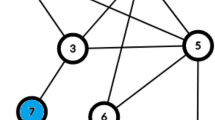Abstract
Local community detection (LCD for short) aims at finding a community structure in a network starting from a seed (i.e., a “local” starting vertex). In a process of LCD, local community metrics are crucial since they serve as the measurements for the quality of the detected local community. Even if various algorithms have been proposed for LCD, there has been few investigation on the key features of these local community metrics, resulting in a lack of guidelines on how to choose these metrics in practice. To make up this inadequacy, this paper first investigates the effectiveness and efficiency of local community metrics via LCD accuracy comparison and scalability study, and then studies the insensitivity of these metrics to different seeds in a target community structure, followed by evaluating their performance on local communities with noisy vertices inside. In addition, a set of guidelines for the selection of local community metrics are given based on our findings concluded from extensive experiments.




Similar content being viewed by others
References
Ahn, Y.Y., Bagrow, J.P., & Lehmann, S. (2010). Link communities reveal multi-scale complexity in networks. Nature, 466, 761–764.
Bagrow, J.P. (2008). Evaluating local community methods in networks. Journal of Statistical Mechanics-Theory and Experiment, 5, P05,001.
Bagrow, J.P., & Bollt, E.M. (2005). Local method for detecting communities. Physical Review E, 72(4), 046–108.
Blondel, V.D., Guillaume, J.L., Lambiotte, R., & Lefebvre, E. (2008). Fast unfolding of communities in large networks. Journal of Statistical Mechanics-Theory and Experiment, P10008.
Chen, J., Zaïane, O.R., & Goebel, R. (2009). Detecting communities in social networks using max-min modularity, SDM (pp. 978–989).
Chen, J., Zaïane, O.R., & Goebel, R. (2009). Local community identification in social networks, ASNAM (pp. 237–242).
Ciglan, M., Laclavik, M., & Nørvåg, K. (2013). On community detection in real-world networks and the importance of degree assortativity, KDD (pp. 1007–1015).
Clauset, A. (2005). Finding local community structure in networks. Physical Review E, 72(2), 026,132.
Coscia, M., Rossetti, G., Giannotti, F., & Pedreschi, D. (2012). Demon: a local-first discovery method for overlapping communities, KDD (pp. 615–623).
Cui, W., Xiao, Y., Wang, H., & Wang, W. (2014). Local search of communities in large graphs, SIGMOD (pp. 991–1002).
Duch, J., & Arenas, A. (2005). Community detection in complex networks using extremal optimization. Physical Review E 72(2).
Fortunato, S. (2010). Community detection in graphs. Physics Reports, 486(3–5), 75–174.
Fortunato, S., & Barthelemy, M. (2007). Resolution limit in community detection. Proceedings of the National Academy of Sciences, 104(1), 36–41.
Girvan, M., & Newman, M.E.J. (2002). Community structure in social and biological networks. Proceedings of the National Academy of Sciences, 99(12), 7821–7826.
Gleich, D.F., & Seshadhri, C. (2012). Vertex neighborhoods, low conductance cuts, and good seeds for local community methods, KDD (pp. 597–605).
Huang, H., Chiew, K., Gao, Y., He, Q., & Li, Q. (2014). Rare category exploration. Expert Systems with Applications, 41(9), 4197–4210.
Huang, H., Gao, Y., Chiew, K., He, Q., & Zheng, B. (2014). Unsupervised analysis of top-k core members in poly-relational networks. Expert Systems with Applications, 41(13), 5689–5710.
Huang, J., Sun, H., Han, J., Deng, H., Sun, Y., & Liu, Y. (2010). Shrink: a structural clustering algorithm for detecting hierarchical communities in networks, CIKM (pp. 219–228).
Huang, J., Sun, H., Liu, Y., Song, Q., & Weninger, T. (2011). Towards online multiresolution community detection in large-scale networks. PLOS ONE, 6(8), e23–829.
Lancichinetti, A., & Fortunato, S. (2009). Community detection algorithms: a comparative analysis. Physical Review E, 80(5), 056–117.
Lancichinetti, A., Fortunato, S., & Kertesz, J. (2009). Detecting the overlapping and hierarchical community structure in complex networks. New Journal of Physics, 11 (033), 015.
Leskovec, J., Kleinberg, J.M., & Faloutsos, C. (2007). Graph evolution: densification and shrinking diameters. ACM Transactions on Knowledge Discovery from Data 1(1).
Leskovec, J., Lang, K.J., & Mahoney, M.W. (2010). Empirical comparison of algorithms for network community detection, WWW (pp. 631–640).
Luo, F., Wang, J.Z., & Promislow, E. (2006). Exploring local community structures in large networks, WI (pp. 233–239).
Ma, L., Huang, H., He, Q., Chiew, K., Wu, J., & Che, Y. (2013). GMAC: a seed-insensitive approach to local community detection, Dawak (pp. 297–308).
Ma, L., Huang, H., He, Q., Chiew, K., & Liu, Z. (2014). Toward seed-insensitive solutions to local community detection. Journal of Intelligent Information Systems, 43 (1), 183–203.
Newman, M.E.J., & Girvan, M. (2004). Finding and evaluating community structure in networks. Physical Review E 69(2).
Shi, J., & Malik, J. (2000). Normalized cuts and image segmentation. IEEE Transactions on Pattern Analysis and Machine Intelligence, 22(8), 888–905.
Shibata, N., Kajikawa, Y., Takeda, Y., Sakata, I., & Matsushima, K. (2011). Detecting emerging research fronts in regenerative medicine by the citation network analysis of scientific publications. Technological Forecasting and Social Change, 78(2), 274–282.
Sun, H., Huang, J., Han, J., Deng, H., Zhao, P., & Feng, B. (2010). Gskeletonclu: density-based network clustering via structure-connected tree division or agglomeration, ICDM (pp. 481–490).
Wang, G., Zhao, Y., Shi, X., & Yu, P.S. (2012). Magnet community identification on social networks, KDD (pp. 588–596).
Watts, D.J., & Strogatz, S.H. (1998). Collective dynamics of small-world networks. Nature, 393(6684), 440–442.
Yang, J., & Leskovec, J. (2012). Defining and evaluating network communities based on ground-truth, ICDM (pp. 745–754).
Zhang, W., Pan, G., Wu, Z., & Li, S. (2013). Online community detection for large complex networks, IJCAI (pp. 1903–1909).
Acknowledgements
This work is partially supported by the National Natural Science Foundation of China under Grant No. 61472359.
Author information
Authors and Affiliations
Corresponding author
Rights and permissions
About this article
Cite this article
Ma, L., Chiew, K., Huang, H. et al. Evaluation of local community metrics: from an experimental perspective. J Intell Inf Syst 51, 1–22 (2018). https://doi.org/10.1007/s10844-017-0480-5
Received:
Revised:
Accepted:
Published:
Issue Date:
DOI: https://doi.org/10.1007/s10844-017-0480-5




